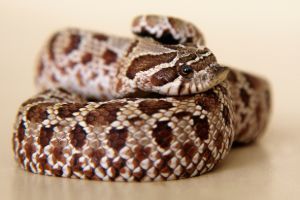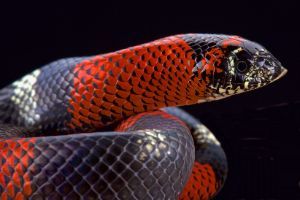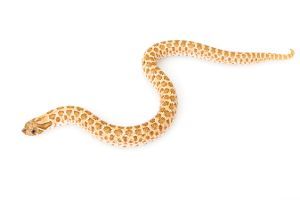This North American colubrid is quickly becoming one of the most popular pet snake species around the world. This snake is low maintenance, eye-catching and small in size. Interesting the diurnal nature of the species means they are active throughout the day.
This makes it easier to interact with it. In North America where they occur, they are inexpensive. A singular captive-bred specimen usually cost under $60. As with any reptile pet, it is best to acquire a captive-bred snake as they are used human interactions.
Quick Reference Section
- Experience Level: Beginner
- Family: Colubridae
- Scientific Name: Heterodon nasicus
- Risk Factor: Nonvenomous, colubrid
- Average Adult Size: 1.4 to 3.6 feet (0.38 to 0.51 m)
- Lifespan: 15 to 20 years
- Clutch Size: 4 to 23 eggs
- Incubation Period: 52 to 64 days
- Food: Frozen mice & rats
- Average Temperature: 90°H/76°L
- Humidity: 30 – 50%
- UVB Lighting: Optional
- Average Price Range: $40 to $60
- Conservation Status: Least Concern on IUCN Red List
Facts and Information

The scientific name of the western hognose snake is Heterodon nasicus and as such belongs to the genus heterodon which is native to the Americas. Other species include the Mexican hog-nosed snake, the Eastern hog-nosed snake, and the Southern hog-nosed snake.
Apart from the nominate subspecies, other subspecies of the Heterodon nasicus include H. n. gloydi and H. n. kennerlyi. The care for both subspecies is the same as the nominate subspecies which we are covering in this care sheet. Similarly, all hognose snakes have similar needs as the western hognose snake.
Some specimens of this species look like rattlesnakes to the untrained eye which can lead to the death of the snake at the hand of a scared human. On the contrary, the western hognose is nonpoisonous and don’t harm humans.
They are small snakes that reach adult lengths of 15 to 20 inches which is 38 to 51cm. They come in several colors including yellow, tan, and brown and have olive oval markings which run down the center of their back. On either side of the oval marks are dark blotches. This snake gets its common name from the shape of its nose which looks like a hog’s nose.
Western Hognose Snake Habitat
In the United States, the Western Hognose Snake can be found in the south of Texas and Arizona, and in isolated populations in Arkansas, Missouri, Illinois, Iowa, Wisconsin, and Minnesota. In Canada, they are endemic to southwestern Manitoba, and southeastern Alberta.
The western hognose is a ground-dwelling snake which prefers arid semi-deserts, scrub and grasslands, and prairies. As you can see, this species doesn’t require high relative humidity levels. This should be taken into account when setting up the enclosure of this snake.
Enclosure
This species is quite a small snake and as such don’t need a lot of space to be comfortable. Since they aren’t arboreal, a short terrarium is best. Ensure that the terrarium is well ventilated and secure. You don’t want the snake to escape the enclosure.
The terrarium used can be made of wood, plastic or even glass. Most snake keepers prefer terrariums with transparent panels as they can easily view the snake. Also, transparent panels make for an attractive reptile showcase. The most important features of any snake terrarium include good ventilation and a secure lid.
For hatchlings and juveniles, use a 5-liter enclosure. Small snakes require small enclosures as large ones can stress them out. A large clear plastic container or a shoebox can serve as an excellent enclosure for hatchlings.
For adults, use a 20-gallon enclosure such as the this Terrarium which measures 24 x 18 x 12 inches. Similarly, if you have several snake specimens, you may want to use 30 to 40-quart plastic boxes such as the Sterilite Large Clip Box. To ensure good ventilation, drill some holes in the plastic box. With that said, a reptile terrarium is best.
Ground dwelling snakes require little decorates since they do not climb. Any decoration is most likely for humans who appreciate the aesthetics. However, hide boxes are a must. Snakes need to hide, in the wild, they hide in natural formations such as burrows, cracks, caves and hollow logs.
To keep them from being stressed, provide three hiding boxes, one over the cool area of the enclosure, another over the warmer part of the enclosure, and finally one in the middle of the enclosure which has a moist substrate such as coco coir to help them shed. Other decorations normally found in the terrarium of a ground-dwelling reptile is a cork bark.
Substrate
The Western Hognose is a snake which resides in areas of low humidity. As such, the choice of substrate doesn’t matter much as far as it is not toxic or abrasive. Sand should be avoided as it poses a threat of impaction. This happens when the snake ingests sand.
You can use newspaper, paper towels, or paper tissues as a substrate for the reptile. They are readily available and easy to replace when dirty. Paper isn’t attractive nor is it natural looking and as such isn’t favored by most snake keepers.
You can also use wood shavings such as Zoo Med aspen snake beddings. Aspen is safe and non-toxic, unlike cedar and pine shavings which should be avoided. The substrate should be about two inches deep so the snake can burrow.
Clean the substrate regularly. Also, every two or so months replace the substrate. For juveniles and new pets, it is advisable to use paper towels or newspaper as they are easy to clean and make it easy to inspect the fecal matter for worms.
Temperature

It is necessary to create a heat gradient when warming up the enclosure. This means that portions of the enclosure need to be warmer than other portions. Heat up just a third of the enclosure so that as the snake moves from the warm spot, the temperature drops steadily. With this, the snake can regulate the body temperature by moving between the warm and cool ends.
With the help of a heat pad like the Zacro Reptile Heat Pad, heat up just a third of the enclosure. For ground-dwelling reptiles, a heat map is better than a heat lamp since the heat radiates close to the snake. The warm basking spot which should be situated at one end of the enclosure needs to have a temperature of 88 to 90 F.
The cool end of the terrarium need to have a temperature of about 75 F. with the help of a thermostat controller such as the Century Digital Heat Mat Thermostat Controller, you can regulate the temperature of the warm end of the enclosure.
Humidity
The enclosure of the hognose snake doesn’t need to be misted as this snake’s natural habitat are semi-arid areas. However, the species still need water. Change the water regularly, about once a week or whenever the water is dirty. The water bowl needs to be heavy and sturdy.
It is best to place the water bowl at the cool end so as to reduce evaporating. Evaporation can significantly increase humidity levels.
Lighting
The hognose snake may not require special lighting however, a full spectrum light such as the Zoo Med Reptisun light helps brightens the snake’s coloration. It is important that the lighting follows a day-night cycle.
During the warm months, summer and spring, the light needs to be on for 14 to 16 hours each day. During the autumn and winter, the light needs to be on for 10 to 8 hours each day. If you are busy and as such cannot turn the lights on and off each day you can use the Century Mechanical Timer.
Feeding the Western Hognose Snake
Once they are used to eating dead prey, feeding it is not difficult. In the wild, they eat toads which is their main food source. However, they do eat rodents, reptiles, and eggs. Their preference for toad can make it difficult to feed. This is especially true of younglings. Dip the warm thawed mouse in warm water before feeding it to a baby. If the it refuses to eat, you can scent the thawed rodent with tuna juice.
As with other snakes, you have to stick to a strict feeding schedule. This will ensure you notice any change in appetite. fastidious feeding schedule ensures the snake doesn’t become obese.
Feed the snake, a thawed mouse which is the same diameter as the snake’s head once or twice a week. The swallowed meal has to result in a noticeable bump. This bump should, however, disappear 24 hours after feeding.
Western Hognose Snake’s Temperament

The hognose snake is a docile reptile which is easy to handle. They really bite or show signs of aggression. When they do bite, it is usually due to an overeager feeding response. While their bites are innocuous, they can be painful. If bitten wash the affected area with soap and water.
As such, it is advisable to feed them using a pair of tongs. If the hognose puff up or bluff, it is best to leave them as handling them at that time is stressful for them. They may also play dead when you try to handle them. When they do this, leave them for a while. They will usually revert to their usual self.
Regular handling is important as it allows the snake to become used to you and comfortable with being held. Once they are comfortable with you handling them, they will stop playing dead.
Western Hognose Snake’s Lifespan
Snakes are known for their long lifespan. The western hognose snake is no exception. This snake will like between 12 and 18 years on average, although they can easily li to be 20 years or more. Lon-term commitment and dedication are needed if you wish to care for the western hognose snake.
Breeding Western Hognose Snakes

Breeding western hognose snakes have been done successfully and regularly. As such, there is no reason to acquire wild specimens of this species. Males reach sexual maturity when they weigh about 70 grams and are a year old. Females, on the other hand, reach maturity/breeding age when they are 2 years and weight at least 250 grams.
Breeding occurs after brumation this lasts between two to three months. After brumation, the hognose are ready to breed. It takes the female 28 to 45 days after mating to lay eggs. Incubation takes 52 to 64 days on average depending on the incubation temperature which must be 78 to 84 F due to how easy it is to breed this species, there are many different morphs available including the anerythristic morph, super conda morph, the yellow albino, the albino, the axanthics, the snow morph.
Health Issues
Although the western hognose is a resilient and hardy snake, it can still fall sick and have health issues just like any reptile. Common health issues and symptoms to be concerned about includes lethargy, loss of appetite, internal parasites, regurgitation, wheezing cough, improper shedding, and mites.
If you notice any of these symptoms contact your local herp vet.
Pricing and Availability
The readily available and popular nature of this species means they are easy to find. As such, the western hognose is an affordable snake. The price range of this reptile is $50 to $150. Different morphs may cost much more though. For instance, albino morphs of this snake can cost over $500.
Some popular online sites that sell western hognose snakes include Underground Reptiles, Snakes at Sunset, Morph Market, LLLReptile, Backwater Reptiles, and XYZ Reptiles.
Conservation/Threats
According to the IUCN Red List, this species is of least concern. The overall population size which is over 100,000 is large and the is widespread. Regardless, the species is protected by conservation programs in the united states. This is because habitat destruction has led to a considerable decline in certain states in the united states including Illinois, and Iowa.
Conclusion
This attractive and small North American colubrid is low maintenance and hardy. They are easy to handle and require little attention. They are a dream for any beginner looking to keep a snake. As far as the snake keeper is committed, this snake is absolutely no hassle.
They are also easy to find in pet shops and online. Setting up their habitat and acquiring them is also relatively cheap as compared to many other snakes. All of these characteristics make them a fan favorite. If you have any questions on this majestic reptile, kindly leave a comment.
More Cool Stuff
- Snake Species
- Green Tree Python
- Rosy Boa Care Sheet
- Best Substrate for Ball Pythons
- Garter Snake Guide
- How to treat Snake Mites
Table of Contents



